Family : Plethodontidae


Text © Prof. Pierangelo Crucitti e Nicolò Pellecchia

English translation by Mario Beltramini
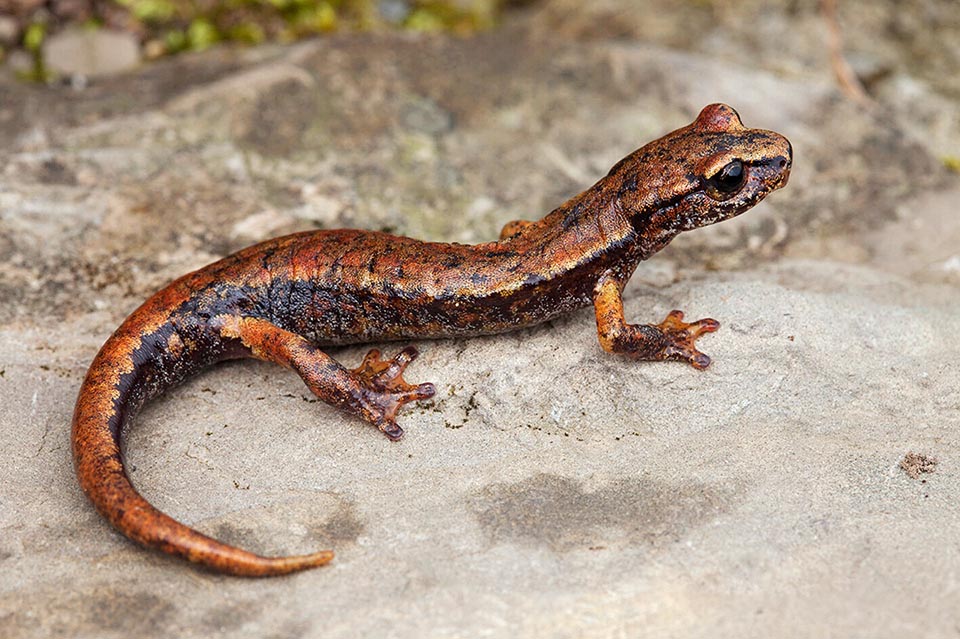
The Italian cave salamander (Hydromantes italicus) is an Italian endemic species, spread in centre-north Apennine, from Emilia-Romagna to Lazio, present also in the Republic of San Marino and well distributed between 80 and 1598 m of altitude. The males and the females reach respectively the 112 and 120 cm © Frank Deschandol
The Italian cave salamander Hydromantes italicus Dunn, 1923 is an amphibian of the order Caudata.
It belongs to the family Plethodontidae subfamily Plethodontinae. The species of this family called cave salamanders, are lucifugous Urodelians, that is, living in more or less cracks in the rock, in the ground under stones and under rotting trunks, in the calcareous grottoes and in the artificial hypogea (i.e. abandoned mine tunnels).
The family Plethodontidae includes more than the 70% (the only neotropical forms more than 40%) of the present Urodelians described until now, with species diffused from northern America to central Bolivia and eastern Brasil, to south-western Europe and to southern Korea included in a high number of rather morphologically different genera.
In the sixties it was believed that the European species were two, belonging to the genus Hydromantes: the Italian cave salamander and the Gene’s cave salamander (Hydromantes geneii) admitting a high number of subspecies.
After more than half a century, the taxonomic status of the genus Hydromantes has radically changed. The species presently accepted are eight, five in Sardinia and three on the continent, two in Italy and one in Italy as well as in France, especially distinct on genetical and biomolecular basis: an increment of 400%!
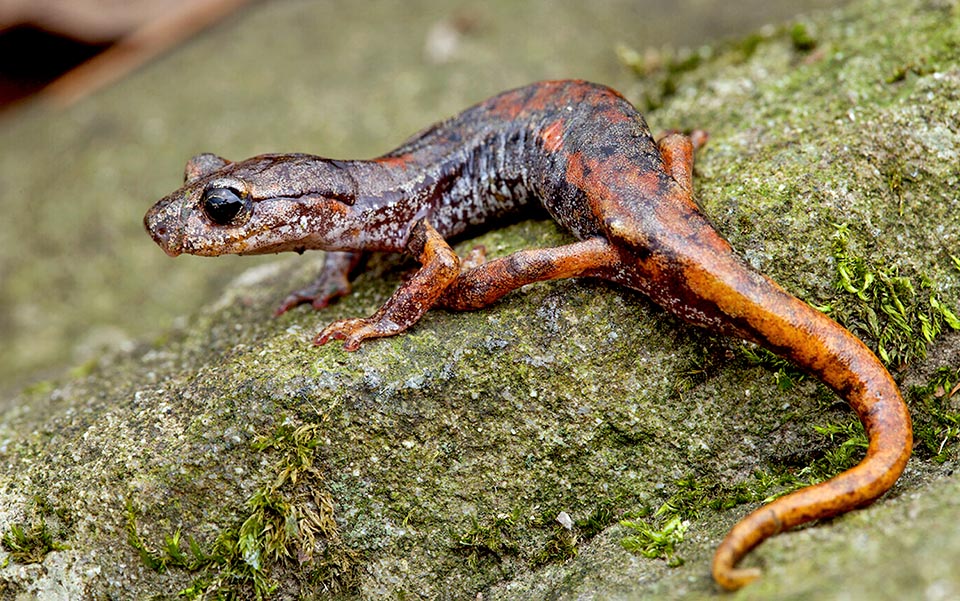
Typically linked to humid zones, it tends to colonize cool valleys carved by water streams or slopes having high humidity rates © Frank Deschandol
The largest increase concerns Sardinia, the continental (peninsular) species passed from one to three, the Sardinian ones from one to five.
Finally, to the tribe of the Hydromantini belongs the Asian species, the Korean crevice salamander (Karsenia koreana) quite recently (2005) described; therefore, overall, two or three genera with at least 14 species.
All the species of Sardinia are endemic, that is, their distribution is limited to one more or less vast portion of the island; similarly, the two peninsular species, the Strinati’s cave salamander (Hydromantes strinatii) could be considered as sub-endemic, being present, as well as in Italy also in a restricted sector of the French southern Alps.
Zoogeography
The distribution range of the Italian cave salamander affects a large part of the central-northern Apennines, resulting present in the regions Emilia-Romagna, Tuscany, Marche, Umbria, Abruzzo and Lazio; it is also present in the Republic of San Marino. The range is consequently between the provinces of Lucca and Reggio Emilia north and the province of Rieti south. The altitudinal distribution is included between 80 m (Garfagnana) and 1.598 m (cavity of the Mount Corchia on the Apuan Alps).
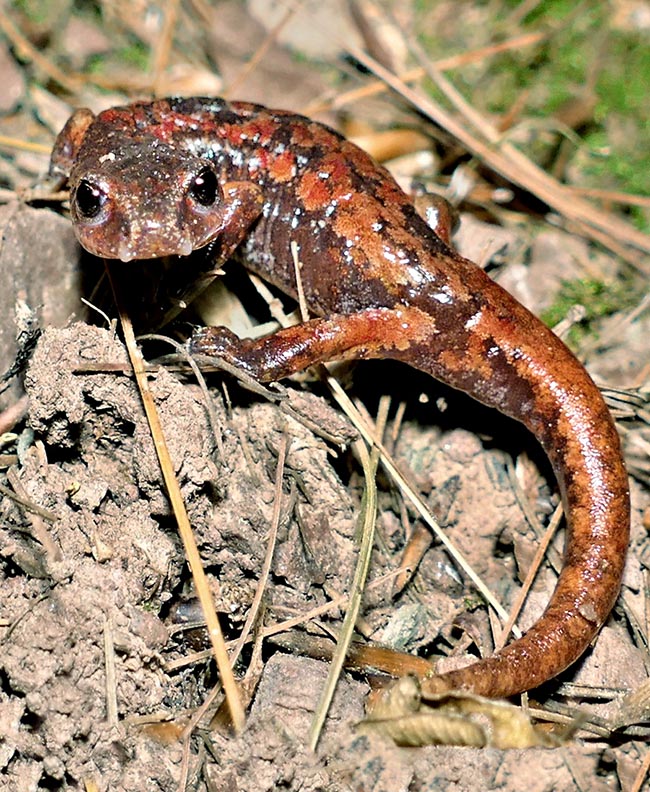
It has a variable back colouration, from burnt umber colour to bistro or blackish, with licheniform spots on the trunk and the tail. The sexual dimorphism can be noted in some well distinguishable characters: males tail longer than in the females, presence of the chin gland and nasolabial cirri more developed as shown here © Paul Bachhausen
This altitudinal interval is characteristic to a Euryzonal species; moreover, its absence from altitudes superior to 1600 m, despite the presence of potentially favourable environments, suggests the following hypotheses: inability to colonize environments above those altitudes; incomplete recolonization of the high mountains after the Quaternary glaciations.
Morphology and Physiology
The Plethodontids display a modest variability morphological and physiological inter- and intra-specific, whilst the genetic variability is quite high, for this reason the utilization of the only morphological characters may be of poor diagnostic value.
Another difficulty for a correct identification comes from frequent instances of allometric growth.
In the species defined “giant” of Sardinia are present morphological characters significantly larger, such as the feet, in respect to the species considered as “normal”.
Hydromantes italicus is a cave salamander of average size, the males and the females reach respectively 112 and 120 mm.
It presents the characters typical to the family Plethodontidae, nasolabial groove, absence of lungs and a large number of teeth, besides a character typical to the tribe of the Bolitoglossini, that is the tongue that can be everted and thrown like a dart for seizing the prey, with the mushroom-shaped terminal part having an adhesive function.
Due to the absence of lungs the breathing takes place by means of the skin and the mucous membranes of the pharyngeal tract and the mouth. The corner between the flat top of the head and the side of the head between head and the muzzle, or “canthus rostrali” is obtuse and normally neat.
The Italian scave lavender, compared to its peninsular congeners, has smaller feet; in the adults the apex snout-cloacal extremity ratio and length of the feet is averagely of 7,98 in the males and 8,15 in the females; the toes have ends not at all or slightly widened, varying from bluntly pointed to moderately truncated. Also the tongue is shorter than the peninsular congeners, and, especially, than the Sardinian ones, the ratio apex muzzle-fore extremity of the cloacal fissure/ distance point of the muzzle-apex of the epibranchial is as an average of 2,24 in the males and 2,19 in the females.
In the length of the tail, we note a certain sexual dimorphism, with the males that generally have a longer tail, the ratio total length/tail length being of about 2,28 in the males and 2,34 in the females.
The pigmentation of the back of the adult individuals is rather variable; the background colour is from umber, burnt or natural, to bistre or blackish, with “licheniform” spots present on the trunk and on the tail.
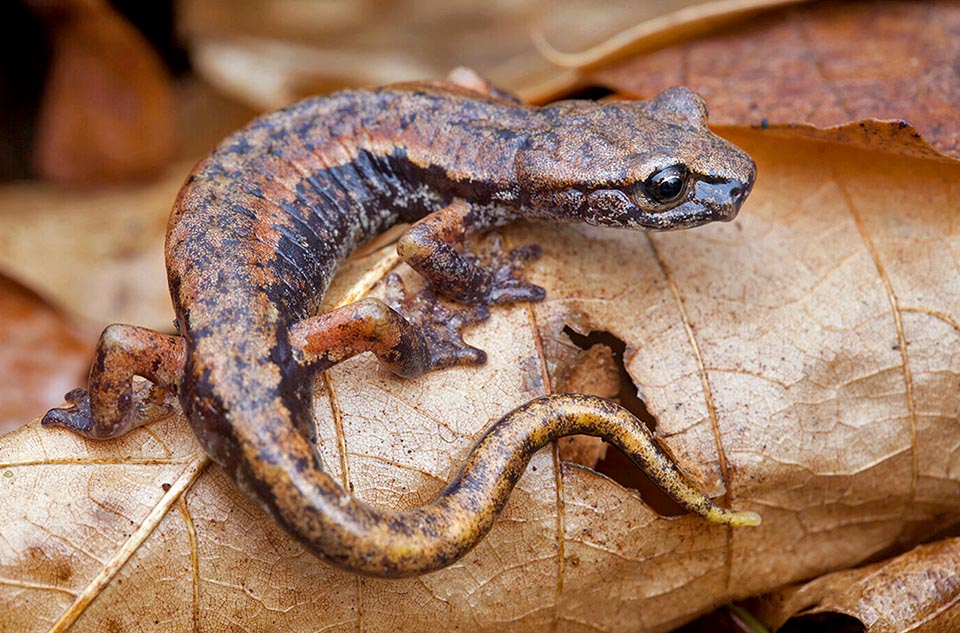
In epigeal habitat the Italian cave salamander can be met mainly by night, or in particularly humid days sheltering in the undergrowth © Frank Deschandol
The spots may be more or less large (type “italicus”) or covering the totality of the back (type “gormani”). In the zones of contact with the Ambrosi’s cave salamander we can observe individuals having a more or less lage black greenish dorsal colouration.
The belly usually has a colouration varying from walnut to bistro or blackish, with whitish to white spots. In the type “italicus” the speckling consists in a more or less thick dotting, whilst in the type “gormani” it consists in more or less sparse little spots.
In addition to the already mentioned cases, the sexual dimorphism in the Italian cave salamander is evidenced by the bigger development of the nasolabial cirri of the males, by the development of the elongated and sharp premaxillary teeth and by the presence of the chin gland, that releases an aphrodisiac substance for mating. The secondary male sexual characters begin to manifest on subjects with a length of muzzle-cloaca of about 40 mm.
Ecology-Habitat
We have already noted how the Italian cave salamander is a euryzonal species, in the range 80-1.600 m asl it frequents Apennines or Mediterranean-Apennines medophylic oods, on different types of substratum.
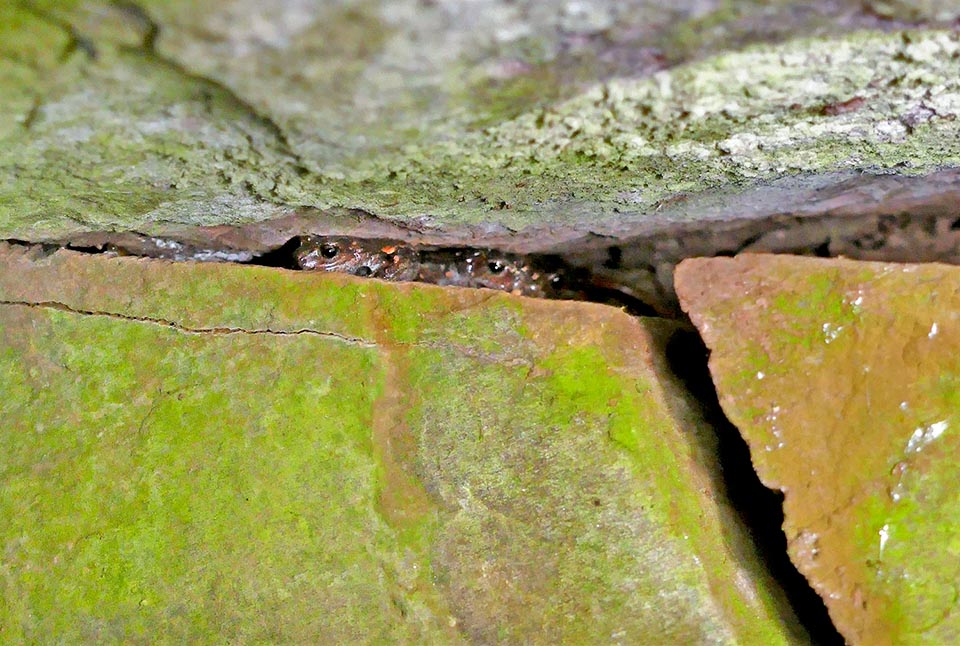
During the day, especially in the warmest hours, it seeks shelter under stones, roots, rotting trunks and natural or artificial cavities in the rocks © Paul Bachhausen
Due to its physiological characteristics, it is a hygrophilous species tending to colonize cool valleys carved by waterways or little exposed to the sun slopes and with a greater level of humidity.
The most commonly described habitat type is that of the natural or artificial cavities.
At seasonal level, the hypogeal activity of the species varies, showing peaks in May and in September, in summer the animals move inside the cavities, at greater distance from the entry.
The animals observed in the epigeal environment are active during the night hours or in particularly humid days, even after heavy rains.
During the warmest hours of the day, the individuals find shelter under stones, rotting trunks, roots or artificial cavities such as dry-stone walls built for the agricultural terracing.
Arboreal activities have also been reported; in this case, most of the surveyed Italian cave salamanders were located at an average height of 31-70 cm, with a maximum height just exceeding 350 cm.
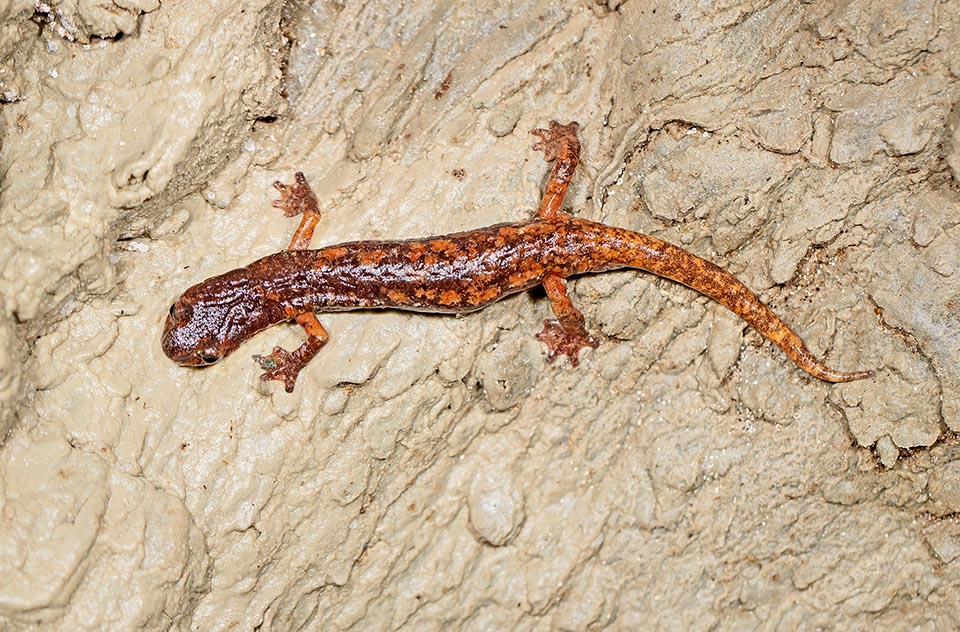
The most common environment where to see it is a grotto. Inside them in fact it finds many favourable conditions. Foremost, the always moderate temperature with the right humidity rate, a good protection from predators and a good diversity of prey: Gastropods, Coleopterans, terrestrial Isopods and Lepidoptera © Giuseppe Molinari
The data concerning its diet are relatively few. The Italian cave salamander eats small Gastropods, Coleopterans, larvae of Lepidoptera and terrestrial Isopods. The diet seems formed mainly by the components of the zoocenoses of transition between the hypogeal environment and the epigeal one.
Recent studies carried on a population of the Umbrian Apennine, have evidenced that based on a qualitative analysis, the population resulted characterized by a broad food spectrum, whilst through an quantitative analysis (number and volume of the preys), has evidenced a more specialized strategy with a clear preference for the dipterans of the family Limoniidae.
For the predation in the darkest parts of the underground cavities the Italian cave salamander uses mainly the sense of smell for identifying the preys, whilst in the brightest zones, that are also those more frequented, it utilizes the eyesight.
Among the few natural predators, we mention the Italian slowworm (Anguis veronensis) and the snakes of the genus Natrix.
The absence of a great number of natural predators is to be associated with the development of effective anti-predatory strategies: poisonous skin secretions, the bite, the immobility or the flight by means of serpentine movements or alternate movements of rolling and stretching that are particularly useful on vertical walls allowing a fast escape.
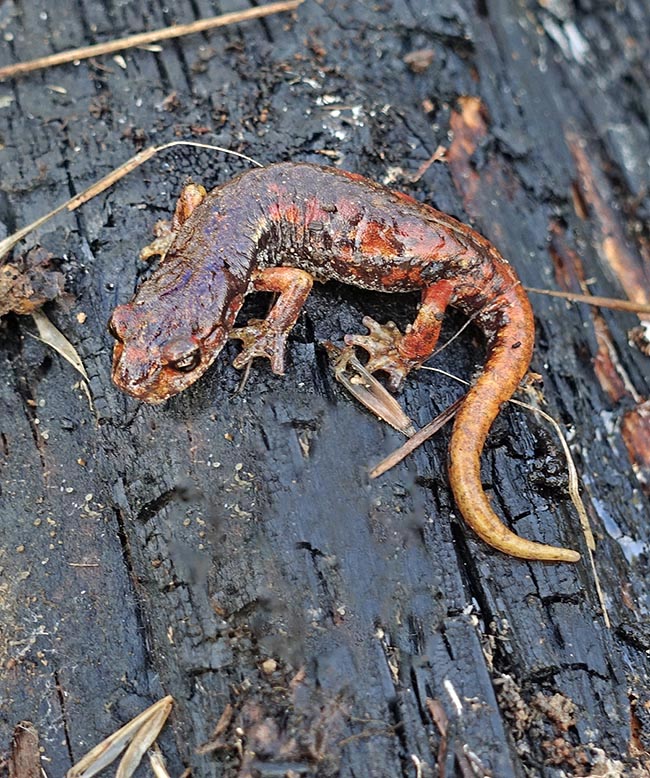
The Italian cave salamander is an oviparous species. The female lays 6 to 16 eggs, usually in underground habitat or anyway always with high humidity rates, like rotting trunks. The laid eggs are terrestrial and have a direct growth. The embryonic development and the eggs hatching lasts from 6-7 and 10-11 months © Nicolò Pellecchia
Ethology and Reproductive Biology
The Italian cave salamander is habitually an oviparous species, the female lays averagely 6-16 eggs, almost always in underground environments or in others, provided highly humid.
Towards the eggs it shows particular parental care, for instance, curling up over them until they hatch and, at times, continuing to protect the young for a short post-hatching period. The period of embryonic development with relevant hatching varies from 6-7 and 10-11 months.
The laid eggs are terrestrial and with direct development, different from other amphibians mainly linked to water.
Upon birth, the young, quite similar to adults and definable “larvae at term” as still presenting a modest remnant of gills, measure 20-30 mm and do not weigh more than 200 mg; have larger nostrils than the adults.
The sexual maturity of the continental cave salamanders is reached by around the three years in the males, about the four years in the females.
It is thought that it can mate during the whole year on the basis, however, of studies carried mainly on individuals in conditions of captivity.
Courting seems to be starting with an exchange of chemical information, the male touches with its snout the female in various parts of the body in order to excite her, exploiting the aphrodisiac qualities of the secretion of its mentum gland.
After this first phase, the male climbs the back of the female, hugging it in a sort of embrace, and carries out the so-called “vaccination”, that is the scarnification with the sharp premaxillae in order to allow the entry into circulation of the aphrodisiac secretion; this ritual may be repeated several times; overall, the duration seems to be of 15 minutes.
The fecundation of the eggs is internal, even if a real mating does not happen, the male, once completed the ritual releases a spermatophore on the soil that then will be sucked up into the cloaca of the female.
In the intra- and inter-specific relationships, it seems that the communication is mainly more chemical than visual, the presence of the nasolabial furrow favours the same, allowing the animal to continuously monitor the chemical characteristics of the substratum in such a way to absorb a wide range of messages, for instance, presence of predators, partner, etc.
Recent studies have ascertained that during the interactions male-male there are no territorial and aggressive attitudes.
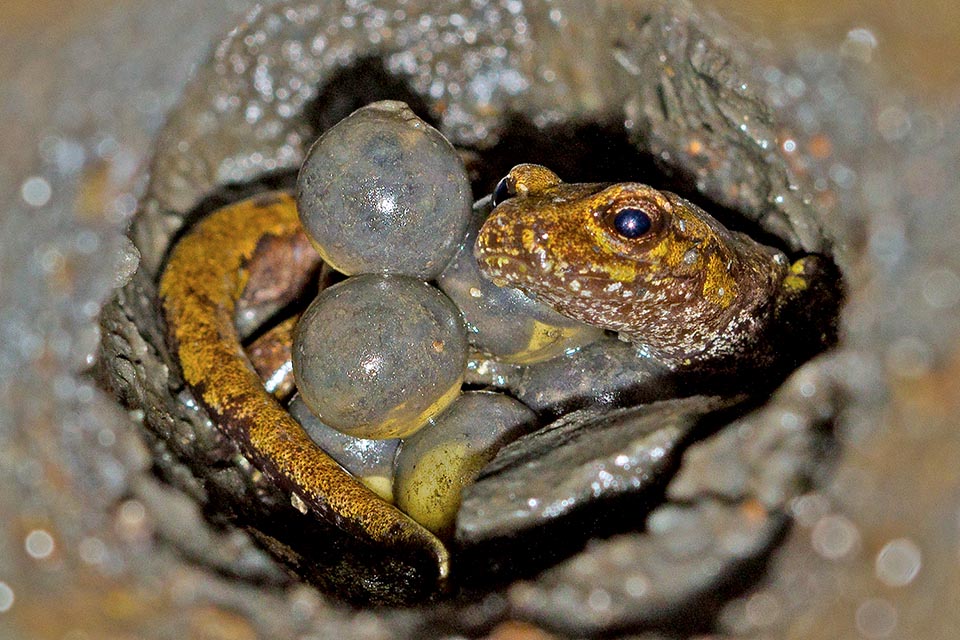
To the eggs mum carries out specific parental care, curling up on them until hatching, and in some cases even more, continuing to control the progeny. Upon birth the young already resemble the adult and are defined larvae at term. They are about 20-30 mm long, with a weight not exceeding the 200 mg © Francesco Bacci
Have been observed instances of cannibalism mainly directed towards small and young individuals and analogously to cases of “selective cannibalism” where the mother eats eggs not fecundated or abnormal with the purpose of avoiding the forming of moulds that might affect the development of the normal eggs.
State of conservation
In general the conservational status permits to assign this species to the category NT ( “near threatened”, that is, potentially threatened”), especially basing on the restricted range. The populations of Hydromantes italicus appear stable, however the disappearance of suitable habitats can occur at a local level; moreover, there is always present the risk of illegal collections of specimens for the most varied purposes (collections, terraristics).
Synonyms
Presently the European cave salamanders, hence also the Italian one, are assigned to the genus Hydromantes subgenus Speleomantes, therefore the complete writing of the taxon should be Hydromantes (Speleomantes) italicus; until not many years ago, they were instead attributed to the genus Speleomantes (Speleomantes italicus Dunn, 1923).
→ For general notions about Caudata please click here.
→ To appreciate the biodiversity within the SALAMANDERS please click here.
